汪建伟对话洪晃——合法性暴力
Art Basel |42| 15-19-11
Against Montage – Intolerance
周啸虎《反蒙太奇-党同伐异》
‘Against Montage – Intolerance” is multimedia work specially commissioned for Art Statements. It continues Zhou Xiaohu’s investigation into the plastic possibilities of sculpture and its relationship to the language of film. Zhou Xiaohu will create eight clay animation videos from scenes adapted from DW Griffith’s seminal film Intolerance (1916). The film presents four parallel stories that depicts acts of intolerance in different periods of history:
1) The fall of Babylon. 2) The "Judean" era and the crucifixion of Jesus. 3) The French Renaissance and the St. Bartholomew's Day Massacre. 4) Modern America (circa 1914).
Inside a black room, eight monitors showing the video animation of each scene are suspended in orbit around a four meter tall spiraling column. The column is composed of black and white resin sculptures cast from the scenes of the video, and displayed in 90 (l) x 65 (w) x 50 (h) cm rectangular frames. Each scene is stacked slightly askew onto one another, simulating the frames of a filmstrip. The scenes are chosen from the climax of Griffith’s film, where the use of montage and the editing technique heightens the tension. The winding of the column alludes to the final scene where the viewer is pulled along, as if by some unseen inertia. The audience sees the four parallel stories all at once within the space, and assembles their own readings and montage through the “cutting” and combination between the different videos, creating new variables, re-routings, deviations and cyclical returns in the space created. It is in these spaces that Zhou Xiaohu sees a possibility for pluralism beyond the political correctness that dominates international political and artistic discourse.
The conventional understanding of montage as a method to suggest the passage of time elides its possibilities and usage as an ideological tool. Griffith’s pioneering use of montage to create psychological and moral linkages between disparate stories became an important tool for filmmakers influencing the likes of John Ford, Alfred Hitchcock and Orson Wells. This power of the montage was further developed by Soviet filmmakers such as Eisenstein and Vertov, who used the technique to create symbolic meaning and would become an important element in Soviet Montage Theory and was heavily capitalized upon in Soviet propaganda film.
To Zhou Xiaohu, the “tolerance” suggested by Griffith in his film, became a declaration of American ideology and values, and a weapon to confirm the validity of a particular ethical standard, one that would come to dominate Hollywood and be transmitted throughout the world. The crusade for ‘tolerance’ has itself become its own negative: it is a restrictive tolerance that conditions the readings towards reality allowing only those voices that fall within its framework. Zhou Xiaohu terms this normalization of thought into an unconscious collective paradigm as a “concentration training camp.”
Zhou Xiaohu pushes the boundaries of sculpture, video, animation and interactive media. Through theatrical narrations, his work examines the disguised spaces between observed living situations and their mediated realities as told through popular media. Engaging with ideas of conformity, progress, censorship and power, Zhou questions the structures of social control in the face of human corruption and greed. His malleable clay theatre ruminates on the fickle nature of memory and on the principles of truth and knowledge, elements that struggle for validity in a regulated media environment.
ZHOU XIAOHU “Against Montage”
Proposal images
Each sculpture 90 cm x 65 cm x 50cm (h) total 8 sculptures
Scene from fall of Babylon. Drawers containing Persian soldiers are pulled out from the odalisque.
ZHOU Xiaohu
Zhou Xiaohu works experimentally with sculptural ideas of video and animation. With a background in sculpture, oil painting and graphic design, Zhou’s work is a dynamic combination of these mediums, reflecting a world in which technology rules and the media is the pinnacle of propaganda and public influence. Best known are Zhou Xiaohu’s clay-mation sculptural installations that showcase meticulously worked video dramas taken from news stories and fictional events, enclosed inside sculptural sets composed of clay figurines (the ‘characters’ used in each clay-mation). Referencing scenes of war, terrorism, international summit meetings, and natural disasters, Zhou satirizes the level of media-control in a digital age, in which public opinion can be manipulated through documented news, and where scenes of war, torture and famine have become commonplace and cease to shock. His work has been exhibited at Tate Liverpool, Liverpool, UK; Kunst Museum, Bern, Switzerland; Shanghai Art Museum, Shanghai, China; and the International Center of Photography, New York, USA and the Museum Moderner Kunst Stiftung Ludwig, Wien, Austria. He has also participated in such art expositions as the Asia Pacific Triennial of Contemporary Art, Brisbane, Australia in 2006; the Sevilla International Art Biennale, Seville, Spain, in 2004.
ZHOU Xiaohu
1960 Born in Changzhou
1989 BFA Sichuan Academy of Fine Arts
Currently lives and works in Shanghai
Selected Solo Exhibitions
2010 Word Chains, Long March Space, Beijing
2009 Concentration Training Camp, Long March Space, Beijing
Military Exercise Camp, Biz Art Centre, Shanghai, China
2007 Renown, Biz Art Centre, Shanghai, China
Selected Group Exhibitions
2010 10,000 Live - Gwangju Biennale, Gwangju, Korea
Celebrate 10 Years of Tate Modern, Tate Modern, London, UK
2009 Europalia China, Royal Museum of Fine Art, Brussels, Belgium
2008 Bourgeoisified Proletariat, Shanghai Songjiang Creative Studio, Shanghai, China
2007 China – Facing Reality, Museum Moderner Kunst Stiftung Ludwig, Wien, Austria
Geopolitics of Animation, Centro Andaluz de Arte Contemporaneo, Sevilla, Spain
Thermocline-New Asian Waves, ZKM, Karlsruhe, Germany
The Real Thing: Contemporary Art from China, Tate Liverpool, Liverpool, UK
2006 Asia Pacific Triennale, Queensland Art Gallery, Brisbane, Australia
Building Code Violations, Long March Space, Beijing, China
Contemporary Chinese Art Exhibition, Zendai Art Gallery, Shanghai, China
2005 Mahjong: Contemporary Chinese Art from the Sigg Collection, Kunst Museum, Bern, Switzerland
Living in Interesting Times - A Decade of New Chinese Photography, The Open Museum of Photography at Tel Hai, Israel
2004 First Seville International Art Biennale, Seville, Spain
Between Past and Future: New Photography and Video from China, International Center of Photography, New York, USA; Smart Museum of Art, Chicago, USA
The Long March Pavilion, Le Moine et le Demon-Chinese Contemporary Art Exhibition, Museum of Contemporary Art, Lyon, France
China Now, The Museum of Modern Art, New York, USA
2003 A Strange Heaven-Contemporary Chinese Photography, Rudolfinum Art Museum, Prague, Czech Republic
Second Hand Reality, Today Art Museum, Beijing, China.
2002 Video Art from Asia, Nikolaj Contemporary Art Center, Copenhagen, Denmark
The Long March – A Walking Visual Display, various sites throughout China
The First Guangzhou Triennial, Guangdong Museum of Art, Guangzhou, China
Golden Autumn, Zagreb National Museum, Zagreb, Croatia
Contemporary Art from China, Kuppersmuhle Museum, Duisburg, Germany
Money and Value/The Last Taboo, Swiss National Bank, Switzerland
2001 1st Chengdu Biennale, Chengdu Contemporary Art Museum, Chengdu, China
China Rushes, Hamburger Bahnhof National Museum, Berlin, Germany
Excess Asia-Pacific New Medial Art Festival, Brisbane, Australia
3rd Bangkok Experimental Film Festival, Bangkok, Thailand
Other Works by Zhou Xiaohu
Montage Structure
Zhou Xiaohu
Sculpture 120 x 62 x 145cm, Video 6 minutes, Ceramic + Video; 2010
DVD video included
Using the body as a slate, the artist created two characters - one male, one female - who come to life once they are drawn on the body. The body and the human characters together take on a life of their own, moving, communicating, and even sometimes fighting, as an expressive and somewhat humorous statement about the never ending power struggles between the sexes.
“The gooey gentleman” is a work of creativity and one of my favorites. It is based on human bodies. The reciprocal love, confrontation and injury between males and females is manifested vividly in a humorous and witty way in terms of the interrelationship between real body behavior and that of animated images of the body. These are animated drawings on what actually occurs to everyone’s body. The creativity of this work lies in the perfect combination of real body behavior with that of virtual animated drawings;of real body images with traditional line—drawing technique;of behavior performance with traditional drawing; of new technology with traditional drawing.(By Li Xianting)
For this clay animation work, Zhou Xiaohu has selected broadcast news episodes, the opening chimes in with the theme of the Chinese national evening news theme. Zhou Xiaohu capitalizes upon the plasticity of clay images' flexibility to create and produce a myth of commercialization of an era’s ideology, material and mental life and realism. Zhou’s works makes it known that “Utopian Machine” is a cultural reality, one that is reflexively recorded by the “Utopian Machine” itself. Zhou Xiaohu subverts not only the reality, but also the way of narrating, making us forget the existence of the video, just as we’ve been alienated into a utopia when we are watching television.
“Concentration Training Camp” is an 8-channel installation that comically parodies the system of indoctrination (what Zhou Xiaohu refers as ‘brainwashing’) in money-making pyramid schemes. In this humorously compelling series of moving images Chinese workers of the American founded company ‘Amway’ are shown in the midst of ‘motivational drills’, where workers yell into microphones with company catch-cry phrases such as ‘Victory Victory Makes Good Winning’ and ‘I want to become a boss unnecessary to work!’. This series of fictional settings is quizzically unsettling for these workers have their hair and clothes seemingly defying gravity, the blood rushing to their heads as if they are hanging upside down. The rooms in which they perform their drills are realistically oriented, further confusing the nature of this space and its conditions. This confusion is a deliberate and humorous element by Zhou Xiaohu whose playful subversion of gravity (performers are acting upside down in suspension) coupled with the military-like drills full of slogans that are uncannily similar in syntax to communist propaganda, makes for a provocative expose of the relationship between political and consumer antics. Amway was launched in China in 1995. In 1998 the Chinese government banned all direct-selling companies after riots ensued due to illegal pyramid schemes. This situation was renegotiated in 2005 and in 2008, Amway China was ranked as this global company’s largest market with over 1,800,000 employees.
[attachment=293230]
Against Montage – Intolerance
周啸虎《反蒙太奇-党同伐异》
‘Against Montage – Intolerance” is multimedia work specially commissioned for Art Statements. It continues Zhou Xiaohu’s investigation into the plastic possibilities of sculpture and its relationship to the language of film. Zhou Xiaohu will create eight clay animation videos from scenes adapted from DW Griffith’s seminal film Intolerance (1916). The film presents four parallel stories that depicts acts of intolerance in different periods of history:
1) The fall of Babylon. 2) The "Judean" era and the crucifixion of Jesus. 3) The French Renaissance and the St. Bartholomew's Day Massacre. 4) Modern America (circa 1914).
Inside a black room, eight monitors showing the video animation of each scene are suspended in orbit around a four meter tall spiraling column. The column is composed of black and white resin sculptures cast from the scenes of the video, and displayed in 90 (l) x 65 (w) x 50 (h) cm rectangular frames. Each scene is stacked slightly askew onto one another, simulating the frames of a filmstrip. The scenes are chosen from the climax of Griffith’s film, where the use of montage and the editing technique heightens the tension. The winding of the column alludes to the final scene where the viewer is pulled along, as if by some unseen inertia. The audience sees the four parallel stories all at once within the space, and assembles their own readings and montage through the “cutting” and combination between the different videos, creating new variables, re-routings, deviations and cyclical returns in the space created. It is in these spaces that Zhou Xiaohu sees a possibility for pluralism beyond the political correctness that dominates international political and artistic discourse.
The conventional understanding of montage as a method to suggest the passage of time elides its possibilities and usage as an ideological tool. Griffith’s pioneering use of montage to create psychological and moral linkages between disparate stories became an important tool for filmmakers influencing the likes of John Ford, Alfred Hitchcock and Orson Wells. This power of the montage was further developed by Soviet filmmakers such as Eisenstein and Vertov, who used the technique to create symbolic meaning and would become an important element in Soviet Montage Theory and was heavily capitalized upon in Soviet propaganda film.
To Zhou Xiaohu, the “tolerance” suggested by Griffith in his film, became a declaration of American ideology and values, and a weapon to confirm the validity of a particular ethical standard, one that would come to dominate Hollywood and be transmitted throughout the world. The crusade for ‘tolerance’ has itself become its own negative: it is a restrictive tolerance that conditions the readings towards reality allowing only those voices that fall within its framework. Zhou Xiaohu terms this normalization of thought into an unconscious collective paradigm as a “concentration training camp.”
Zhou Xiaohu pushes the boundaries of sculpture, video, animation and interactive media. Through theatrical narrations, his work examines the disguised spaces between observed living situations and their mediated realities as told through popular media. Engaging with ideas of conformity, progress, censorship and power, Zhou questions the structures of social control in the face of human corruption and greed. His malleable clay theatre ruminates on the fickle nature of memory and on the principles of truth and knowledge, elements that struggle for validity in a regulated media environment.
ZHOU XIAOHU “Against Montage”
Proposal images
Each sculpture 90 cm x 65 cm x 50cm (h) total 8 sculptures
Scene from fall of Babylon. Drawers containing Persian soldiers are pulled out from the odalisque.
ZHOU Xiaohu
Zhou Xiaohu works experimentally with sculptural ideas of video and animation. With a background in sculpture, oil painting and graphic design, Zhou’s work is a dynamic combination of these mediums, reflecting a world in which technology rules and the media is the pinnacle of propaganda and public influence. Best known are Zhou Xiaohu’s clay-mation sculptural installations that showcase meticulously worked video dramas taken from news stories and fictional events, enclosed inside sculptural sets composed of clay figurines (the ‘characters’ used in each clay-mation). Referencing scenes of war, terrorism, international summit meetings, and natural disasters, Zhou satirizes the level of media-control in a digital age, in which public opinion can be manipulated through documented news, and where scenes of war, torture and famine have become commonplace and cease to shock. His work has been exhibited at Tate Liverpool, Liverpool, UK; Kunst Museum, Bern, Switzerland; Shanghai Art Museum, Shanghai, China; and the International Center of Photography, New York, USA and the Museum Moderner Kunst Stiftung Ludwig, Wien, Austria. He has also participated in such art expositions as the Asia Pacific Triennial of Contemporary Art, Brisbane, Australia in 2006; the Sevilla International Art Biennale, Seville, Spain, in 2004.
ZHOU Xiaohu
1960 Born in Changzhou
1989 BFA Sichuan Academy of Fine Arts
Currently lives and works in Shanghai
Selected Solo Exhibitions
2010 Word Chains, Long March Space, Beijing
2009 Concentration Training Camp, Long March Space, Beijing
Military Exercise Camp, Biz Art Centre, Shanghai, China
2007 Renown, Biz Art Centre, Shanghai, China
Selected Group Exhibitions
2010 10,000 Live - Gwangju Biennale, Gwangju, Korea
Celebrate 10 Years of Tate Modern, Tate Modern, London, UK
2009 Europalia China, Royal Museum of Fine Art, Brussels, Belgium
2008 Bourgeoisified Proletariat, Shanghai Songjiang Creative Studio, Shanghai, China
2007 China – Facing Reality, Museum Moderner Kunst Stiftung Ludwig, Wien, Austria
Geopolitics of Animation, Centro Andaluz de Arte Contemporaneo, Sevilla, Spain
Thermocline-New Asian Waves, ZKM, Karlsruhe, Germany
The Real Thing: Contemporary Art from China, Tate Liverpool, Liverpool, UK
2006 Asia Pacific Triennale, Queensland Art Gallery, Brisbane, Australia
Building Code Violations, Long March Space, Beijing, China
Contemporary Chinese Art Exhibition, Zendai Art Gallery, Shanghai, China
2005 Mahjong: Contemporary Chinese Art from the Sigg Collection, Kunst Museum, Bern, Switzerland
Living in Interesting Times - A Decade of New Chinese Photography, The Open Museum of Photography at Tel Hai, Israel
2004 First Seville International Art Biennale, Seville, Spain
Between Past and Future: New Photography and Video from China, International Center of Photography, New York, USA; Smart Museum of Art, Chicago, USA
The Long March Pavilion, Le Moine et le Demon-Chinese Contemporary Art Exhibition, Museum of Contemporary Art, Lyon, France
China Now, The Museum of Modern Art, New York, USA
2003 A Strange Heaven-Contemporary Chinese Photography, Rudolfinum Art Museum, Prague, Czech Republic
Second Hand Reality, Today Art Museum, Beijing, China.
2002 Video Art from Asia, Nikolaj Contemporary Art Center, Copenhagen, Denmark
The Long March – A Walking Visual Display, various sites throughout China
The First Guangzhou Triennial, Guangdong Museum of Art, Guangzhou, China
Golden Autumn, Zagreb National Museum, Zagreb, Croatia
Contemporary Art from China, Kuppersmuhle Museum, Duisburg, Germany
Money and Value/The Last Taboo, Swiss National Bank, Switzerland
2001 1st Chengdu Biennale, Chengdu Contemporary Art Museum, Chengdu, China
China Rushes, Hamburger Bahnhof National Museum, Berlin, Germany
Excess Asia-Pacific New Medial Art Festival, Brisbane, Australia
3rd Bangkok Experimental Film Festival, Bangkok, Thailand
Other Works by Zhou Xiaohu
Montage Structure
Zhou Xiaohu
Sculpture 120 x 62 x 145cm, Video 6 minutes, Ceramic + Video; 2010
DVD video included
Using the body as a slate, the artist created two characters - one male, one female - who come to life once they are drawn on the body. The body and the human characters together take on a life of their own, moving, communicating, and even sometimes fighting, as an expressive and somewhat humorous statement about the never ending power struggles between the sexes.
“The gooey gentleman” is a work of creativity and one of my favorites. It is based on human bodies. The reciprocal love, confrontation and injury between males and females is manifested vividly in a humorous and witty way in terms of the interrelationship between real body behavior and that of animated images of the body. These are animated drawings on what actually occurs to everyone’s body. The creativity of this work lies in the perfect combination of real body behavior with that of virtual animated drawings;of real body images with traditional line—drawing technique;of behavior performance with traditional drawing; of new technology with traditional drawing.(By Li Xianting)
For this clay animation work, Zhou Xiaohu has selected broadcast news episodes, the opening chimes in with the theme of the Chinese national evening news theme. Zhou Xiaohu capitalizes upon the plasticity of clay images' flexibility to create and produce a myth of commercialization of an era’s ideology, material and mental life and realism. Zhou’s works makes it known that “Utopian Machine” is a cultural reality, one that is reflexively recorded by the “Utopian Machine” itself. Zhou Xiaohu subverts not only the reality, but also the way of narrating, making us forget the existence of the video, just as we’ve been alienated into a utopia when we are watching television.
“Concentration Training Camp” is an 8-channel installation that comically parodies the system of indoctrination (what Zhou Xiaohu refers as ‘brainwashing’) in money-making pyramid schemes. In this humorously compelling series of moving images Chinese workers of the American founded company ‘Amway’ are shown in the midst of ‘motivational drills’, where workers yell into microphones with company catch-cry phrases such as ‘Victory Victory Makes Good Winning’ and ‘I want to become a boss unnecessary to work!’. This series of fictional settings is quizzically unsettling for these workers have their hair and clothes seemingly defying gravity, the blood rushing to their heads as if they are hanging upside down. The rooms in which they perform their drills are realistically oriented, further confusing the nature of this space and its conditions. This confusion is a deliberate and humorous element by Zhou Xiaohu whose playful subversion of gravity (performers are acting upside down in suspension) coupled with the military-like drills full of slogans that are uncannily similar in syntax to communist propaganda, makes for a provocative expose of the relationship between political and consumer antics. Amway was launched in China in 1995. In 1998 the Chinese government banned all direct-selling companies after riots ensued due to illegal pyramid schemes. This situation was renegotiated in 2005 and in 2008, Amway China was ranked as this global company’s largest market with over 1,800,000 employees.
[attachment=293230]
6月15日-9月11日周啸虎参加伦敦Barbican艺术中心群展《Watch Me Move》,参展作品The Gooey Gentleman(蜜糖先生)
[attachment=293231]
大家可以下载文件看资讯,稍后图片献上~
党同伐异 剧照
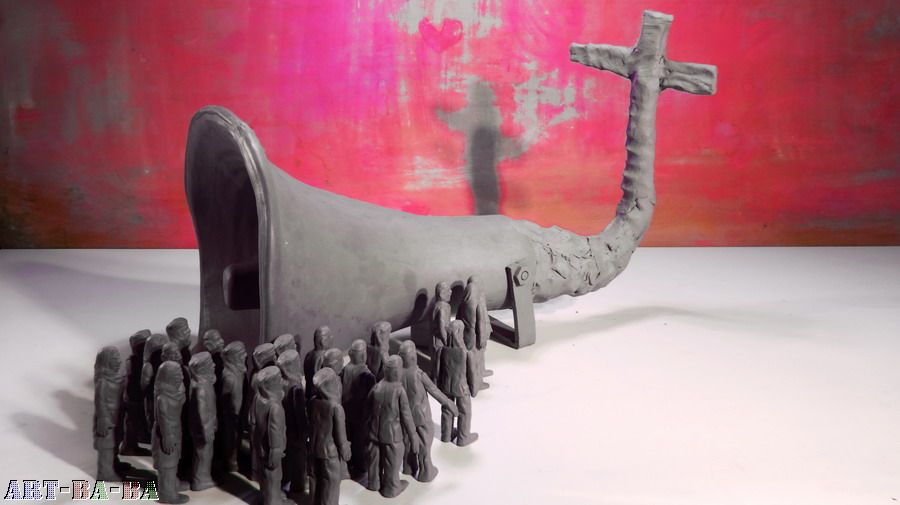
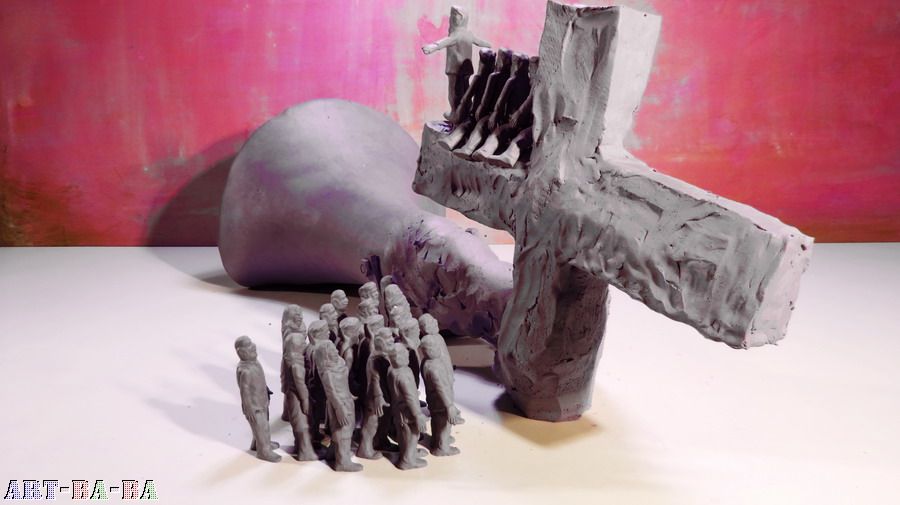
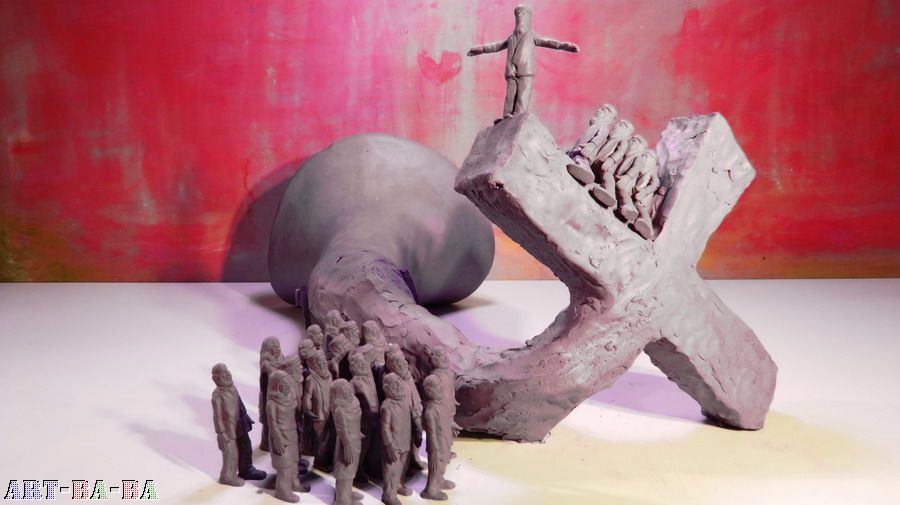
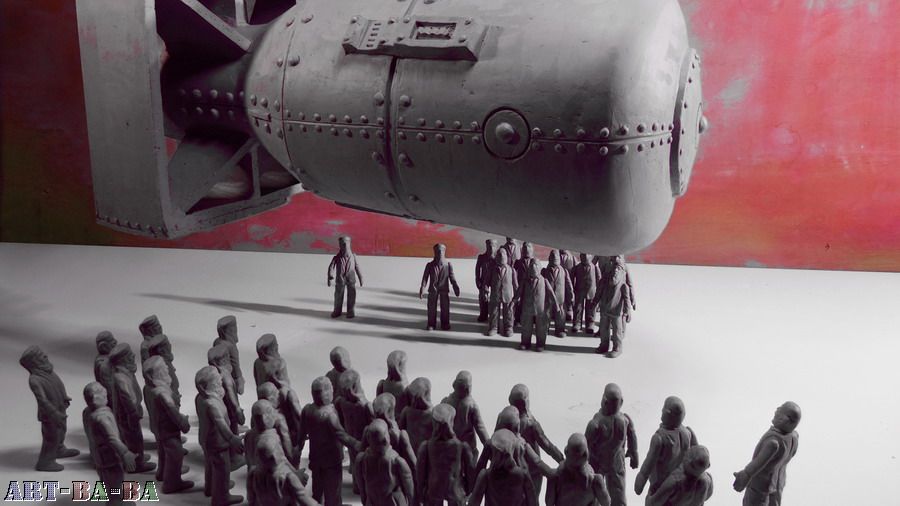
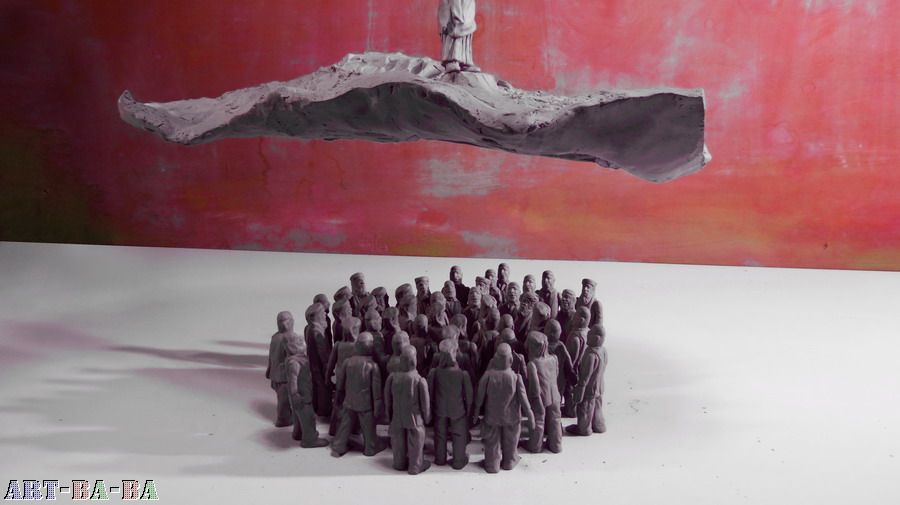
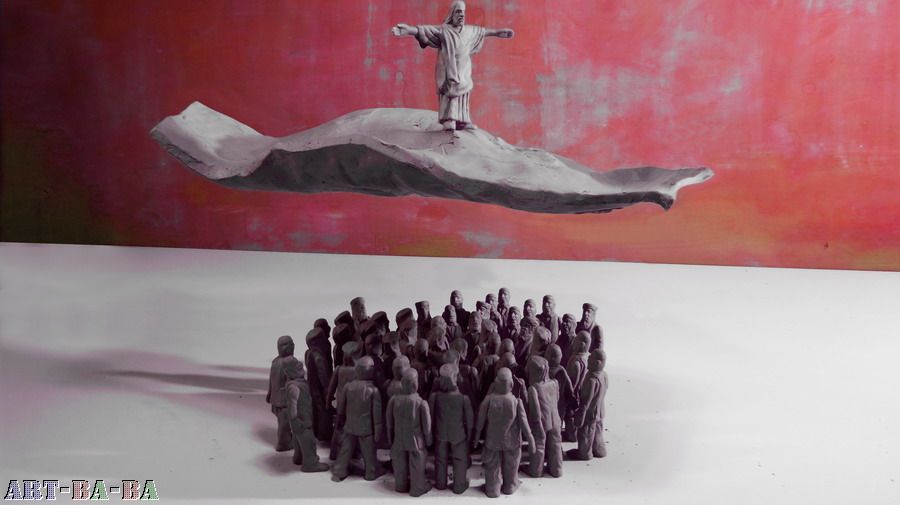
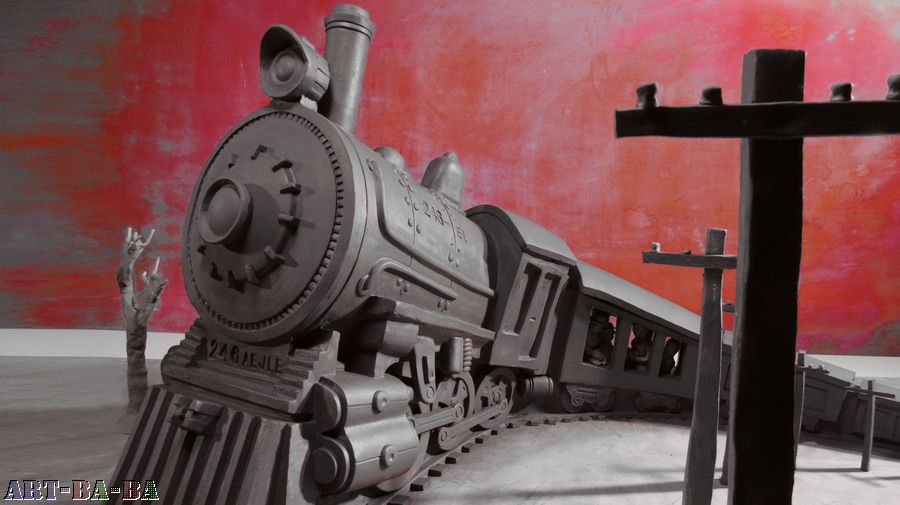
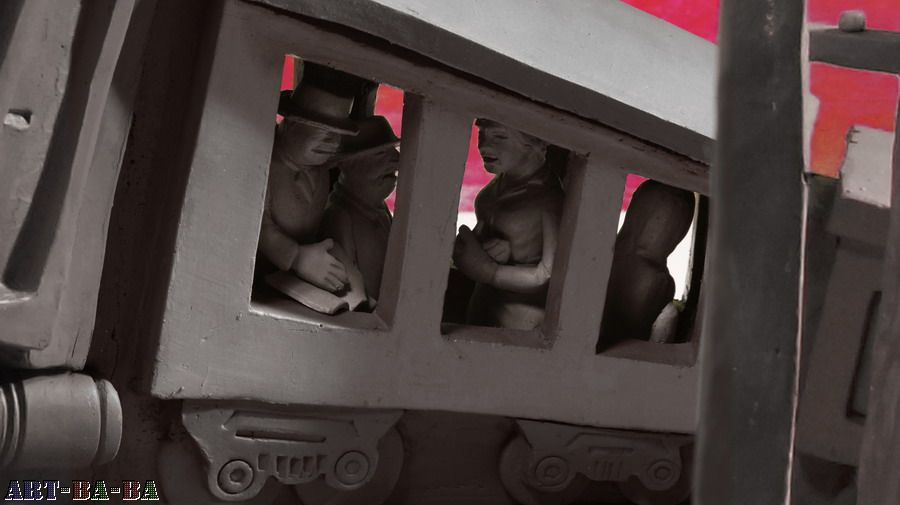
ART BASEL |42| 6月15-19日“艺术声明“单元 周啸虎个展装置图
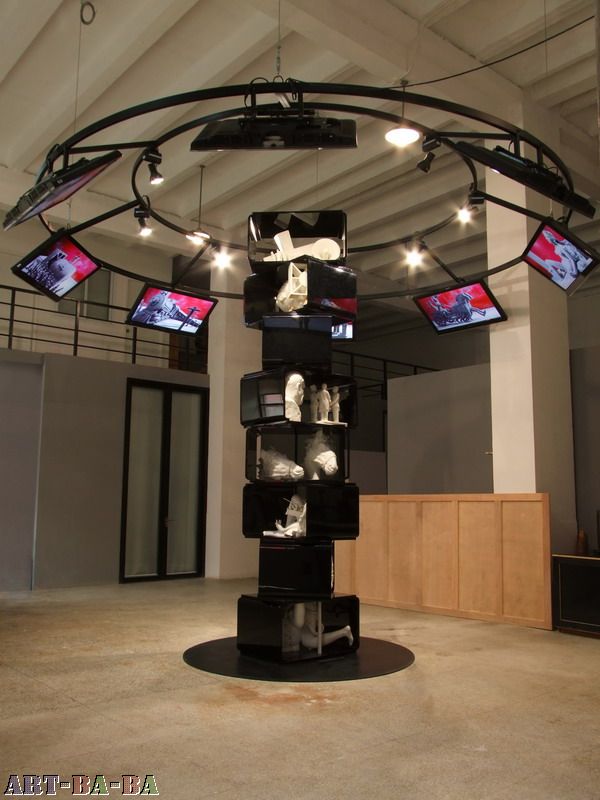
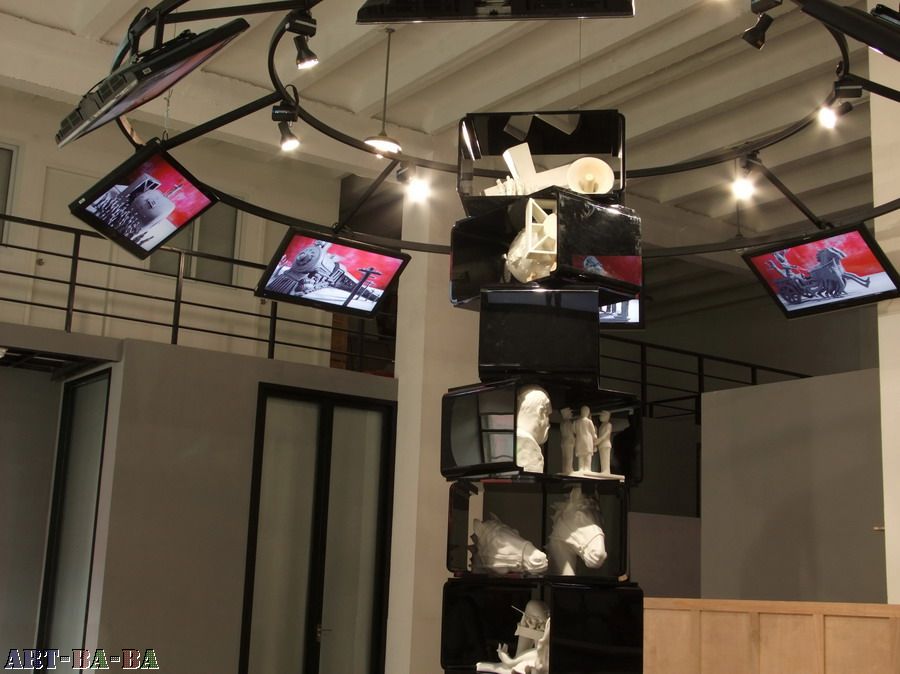
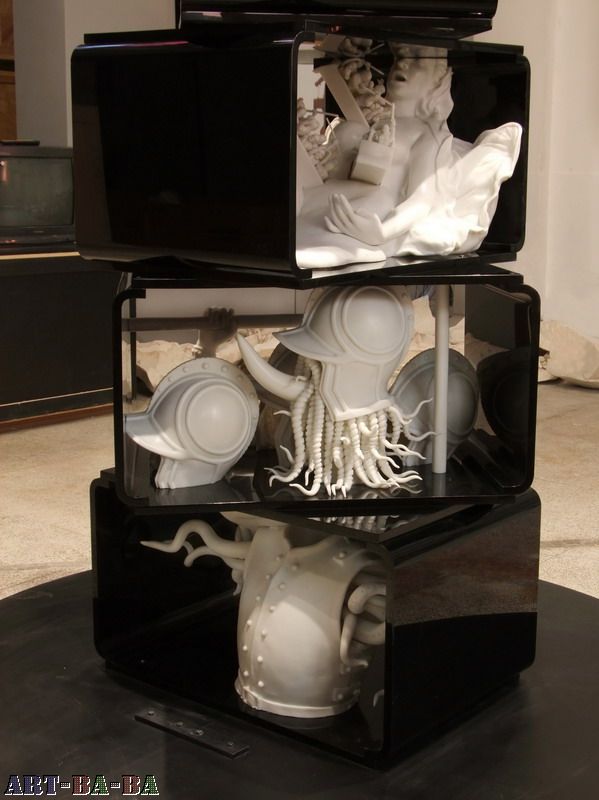
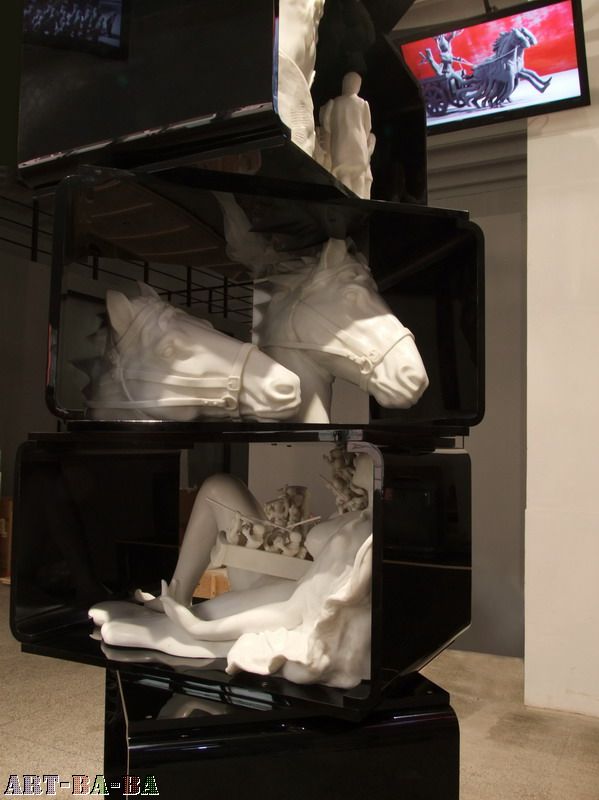
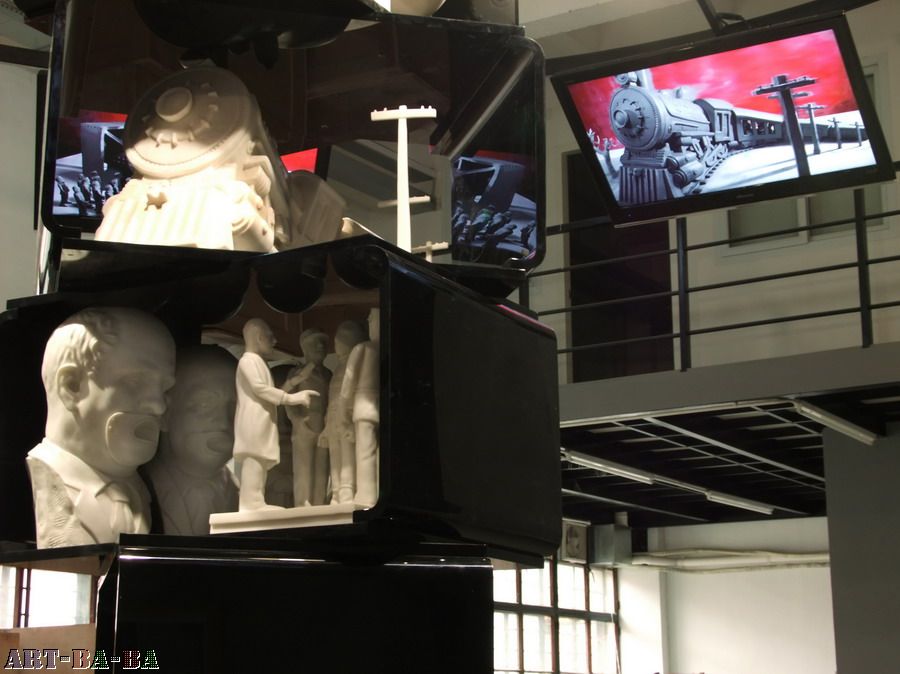
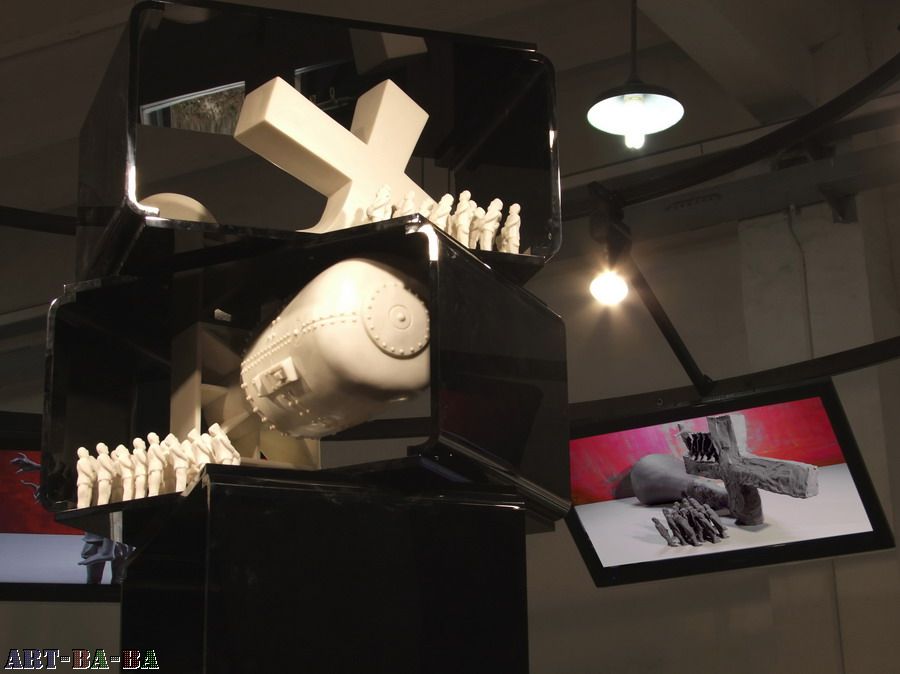
周啸虎《蜜糖先生》剧照
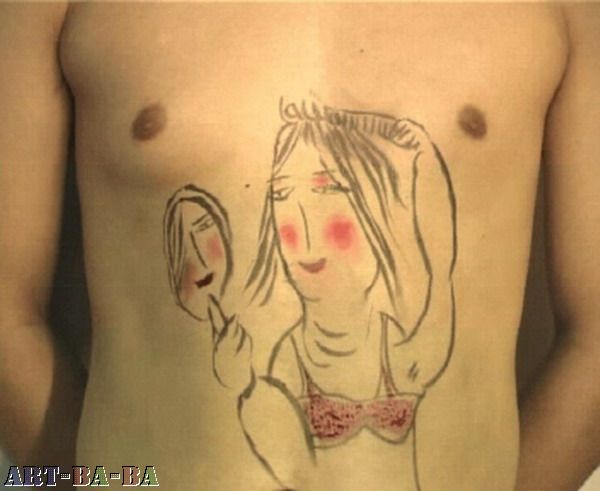
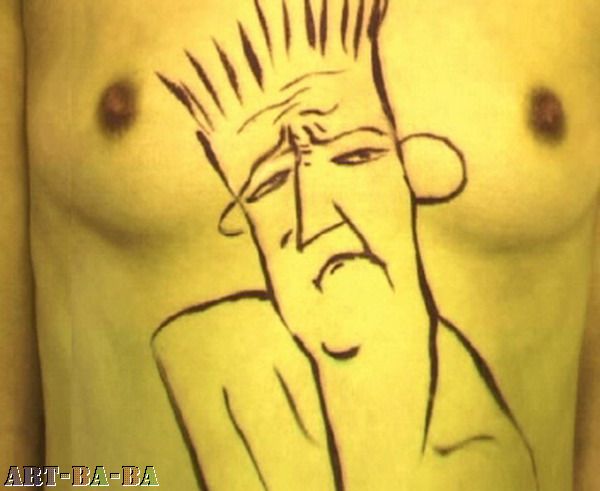
周啸虎
(生于1960年,江苏省常州市)是中国当代艺术家中最早尝试将雕塑观念与动画和影像相结合的艺术家之一。周啸虎有雕塑、油画和艺术设计的专业背景,他将这些媒介手段都综合运用在自己的创作当中,反映了一个以技术规则和媒体作为尖端的宣传和公共影响力的世界。
周啸虎最具代表性的作品是他的具有戏剧特点的陶土动画装置系列,这些作品均取材于新闻事件或者虚构的故事。在搭建的“舞台”上,艺术家将一个个陶土雕塑模拟成故事场景,并且拍摄成动画影像。周啸虎将战争、反恐、国际峰会和自然灾害等场景都搬到作品当中,讽刺了被媒体控制的数字时代的基准,在那里,公众的观点往往被新闻记录所操控,并且那些战争、伤害和饥荒的场面变得司空见惯,以至于不再触动人心。
周啸虎的作品被具有历史意义的2000年上海双年展和2004年“过去与未来之间:来自中国的新摄影与影像”展所收录。此外,他的作品也曾在美国纽约现代艺术馆(MOMA);英国泰特利物浦美术馆;瑞士的伯尔尼美术馆;上海美术馆;美国纽约国际摄影中心;以及奥地利维也纳的路德维希基金会现代艺术馆等地展出。他还参加了2006年澳大利亚布里斯班亚太三年展;2004年西班牙塞维利亚国际艺术双年展等。
周啸虎
1960年 生于中国江苏省常州市。
1989年 毕业于中国四川美术学院。
个展
2009年 “集训营” 周啸虎个展,长征空间,北京,中国。
2007年 “传闻” 周啸虎个展,上海比翼艺术中心,上海,中国。
2005年 “周啸虎个展”依森.柯恩画廊,纽约,美国。
2002年 “周啸虎摄影作品展”莫斯科艺术博览会,俄罗斯。
1989年 自选作品展,四川美术学院,重庆,中国。
群展
2007年
“新亚洲浪潮”,ZKM,卡尔斯鲁厄,德国。
“真事”,泰特画廊,利物浦,英国。
2006年
第5届亚太当代艺术三年展,昆士兰现代艺术馆,澳大利亚。
违章建筑,长征空间,北京,中国。
中国当代艺术奖获奖作品展,上海证大现代美术馆,中国。
“个展”2577创意大院,上海,中国。
“出门必带摄像机”ICO基金会,马德里,西班牙。
“新城市的本体”波依曼斯美术馆,鹿特丹,荷兰。
2005年
“2005亚洲城市网”汉城美术馆,汉城,韩国。
“宽容和特性”海牙自由艺术学院,海牙,荷兰。
“回到未来”汉诺威浮士德美术馆,汉诺威,德国。
“麻将”伯尔尼美术馆,伯尔尼,瑞士。
“闪现”上海多仑现代美术馆,上海,中国。
“平行输入”台北当代美术馆,台北,中国。
2004年
“中国人”沃尔夫斯柏格美术馆,德国。
首届塞维利亚双年展,玛利亚修道院,塞维利亚,西班牙。
“过去与未来之间”国际摄影中心,纽约,美国。
“美景的破产/破产的美景”,米罗基金会,巴塞罗那,西班牙。
21st世界录像节,阿姆斯特丹电影博物馆,阿姆斯特丹,荷兰。
“中国——身体?”马赛当代美术馆,法国。
“此时中国”纽约现代美术馆,纽约,美国。
“窗外——娱乐空间”,日本国际交流基金会,东京,日本。
《里里外外-中国当代艺术展》长征馆,里昂当代美术馆,法国。
《轻而易举-上海拼图 2000-2004》长征馆,挪威国家当代美术馆。
《中国》巴黎 法国Wallonie-Bruxelles中心。
“左翼——中国当代艺术展”左岸工社,北京,中国。
“新地带——中国艺术”,萨切特国家美術館,华沙,波兰。
2003杜塞多夫大展,杜塞多夫当代艺术宫,德国。
“幻影天堂——中華當代攝影展”,鲁道夫美術館,布拉格,捷克。
第56届洛加诺国际电影节--录像装置特展,洛加诺,瑞士。
第36届休斯敦国际电影节,休斯敦美雅兰剧院,休斯敦,美国。
“面对雨果”,雨果博物馆,巴黎,法国。
2002年
“来自亚洲的录像艺术”哥本哈根尼科拉当代艺术中心,丹麦。
首届广州三年展,广东美术馆,广州,中国。
“海市蜃楼”,苏州美术馆,苏州,中国。
“金色的秋天”克罗地亚国家美术馆,萨格勒布,克罗地亚。
“来自中国的当代艺术”库普斯墨赫美术馆,杜依斯堡,德国。
第四届录像马拉松年展,杰诺尔艺术中心,纽约,美国。
“金钱与价值:最后的禁忌”,瑞士国家银行,瑞士。
“新亚洲的未来”,宽勋美术馆,汉城,韩国。
2001年
“米”香港太空馆,香港,中国。
中国录像艺术,汉堡火车站美术馆,柏林,德国。
“非线性叙事”新媒体艺术节,中国美术学院陈列馆,杭州,中国。
"超载"亚太媒体艺术节,布里斯班,澳大利亚。
第三届曼谷实验电影节,曼谷,泰国。
2000年
上海双年展,上海美术馆,上海。中国。
1989年
选择艺术展,四川美术学院,重庆,中国
获奖
2002 中国当代艺术奖
2003 第36届休斯敦国际电影节实验录像类金奖
(生于1960年,江苏省常州市)是中国当代艺术家中最早尝试将雕塑观念与动画和影像相结合的艺术家之一。周啸虎有雕塑、油画和艺术设计的专业背景,他将这些媒介手段都综合运用在自己的创作当中,反映了一个以技术规则和媒体作为尖端的宣传和公共影响力的世界。
周啸虎最具代表性的作品是他的具有戏剧特点的陶土动画装置系列,这些作品均取材于新闻事件或者虚构的故事。在搭建的“舞台”上,艺术家将一个个陶土雕塑模拟成故事场景,并且拍摄成动画影像。周啸虎将战争、反恐、国际峰会和自然灾害等场景都搬到作品当中,讽刺了被媒体控制的数字时代的基准,在那里,公众的观点往往被新闻记录所操控,并且那些战争、伤害和饥荒的场面变得司空见惯,以至于不再触动人心。
周啸虎的作品被具有历史意义的2000年上海双年展和2004年“过去与未来之间:来自中国的新摄影与影像”展所收录。此外,他的作品也曾在美国纽约现代艺术馆(MOMA);英国泰特利物浦美术馆;瑞士的伯尔尼美术馆;上海美术馆;美国纽约国际摄影中心;以及奥地利维也纳的路德维希基金会现代艺术馆等地展出。他还参加了2006年澳大利亚布里斯班亚太三年展;2004年西班牙塞维利亚国际艺术双年展等。
周啸虎
1960年 生于中国江苏省常州市。
1989年 毕业于中国四川美术学院。
个展
2009年 “集训营” 周啸虎个展,长征空间,北京,中国。
2007年 “传闻” 周啸虎个展,上海比翼艺术中心,上海,中国。
2005年 “周啸虎个展”依森.柯恩画廊,纽约,美国。
2002年 “周啸虎摄影作品展”莫斯科艺术博览会,俄罗斯。
1989年 自选作品展,四川美术学院,重庆,中国。
群展
2007年
“新亚洲浪潮”,ZKM,卡尔斯鲁厄,德国。
“真事”,泰特画廊,利物浦,英国。
2006年
第5届亚太当代艺术三年展,昆士兰现代艺术馆,澳大利亚。
违章建筑,长征空间,北京,中国。
中国当代艺术奖获奖作品展,上海证大现代美术馆,中国。
“个展”2577创意大院,上海,中国。
“出门必带摄像机”ICO基金会,马德里,西班牙。
“新城市的本体”波依曼斯美术馆,鹿特丹,荷兰。
2005年
“2005亚洲城市网”汉城美术馆,汉城,韩国。
“宽容和特性”海牙自由艺术学院,海牙,荷兰。
“回到未来”汉诺威浮士德美术馆,汉诺威,德国。
“麻将”伯尔尼美术馆,伯尔尼,瑞士。
“闪现”上海多仑现代美术馆,上海,中国。
“平行输入”台北当代美术馆,台北,中国。
2004年
“中国人”沃尔夫斯柏格美术馆,德国。
首届塞维利亚双年展,玛利亚修道院,塞维利亚,西班牙。
“过去与未来之间”国际摄影中心,纽约,美国。
“美景的破产/破产的美景”,米罗基金会,巴塞罗那,西班牙。
21st世界录像节,阿姆斯特丹电影博物馆,阿姆斯特丹,荷兰。
“中国——身体?”马赛当代美术馆,法国。
“此时中国”纽约现代美术馆,纽约,美国。
“窗外——娱乐空间”,日本国际交流基金会,东京,日本。
《里里外外-中国当代艺术展》长征馆,里昂当代美术馆,法国。
《轻而易举-上海拼图 2000-2004》长征馆,挪威国家当代美术馆。
《中国》巴黎 法国Wallonie-Bruxelles中心。
“左翼——中国当代艺术展”左岸工社,北京,中国。
“新地带——中国艺术”,萨切特国家美術館,华沙,波兰。
2003杜塞多夫大展,杜塞多夫当代艺术宫,德国。
“幻影天堂——中華當代攝影展”,鲁道夫美術館,布拉格,捷克。
第56届洛加诺国际电影节--录像装置特展,洛加诺,瑞士。
第36届休斯敦国际电影节,休斯敦美雅兰剧院,休斯敦,美国。
“面对雨果”,雨果博物馆,巴黎,法国。
2002年
“来自亚洲的录像艺术”哥本哈根尼科拉当代艺术中心,丹麦。
首届广州三年展,广东美术馆,广州,中国。
“海市蜃楼”,苏州美术馆,苏州,中国。
“金色的秋天”克罗地亚国家美术馆,萨格勒布,克罗地亚。
“来自中国的当代艺术”库普斯墨赫美术馆,杜依斯堡,德国。
第四届录像马拉松年展,杰诺尔艺术中心,纽约,美国。
“金钱与价值:最后的禁忌”,瑞士国家银行,瑞士。
“新亚洲的未来”,宽勋美术馆,汉城,韩国。
2001年
“米”香港太空馆,香港,中国。
中国录像艺术,汉堡火车站美术馆,柏林,德国。
“非线性叙事”新媒体艺术节,中国美术学院陈列馆,杭州,中国。
"超载"亚太媒体艺术节,布里斯班,澳大利亚。
第三届曼谷实验电影节,曼谷,泰国。
2000年
上海双年展,上海美术馆,上海。中国。
1989年
选择艺术展,四川美术学院,重庆,中国
获奖
2002 中国当代艺术奖
2003 第36届休斯敦国际电影节实验录像类金奖
老周大制作


2011 Art Basel 同时, 伦敦Barbican艺术中心《Watch Me Move》6月15日同时开幕